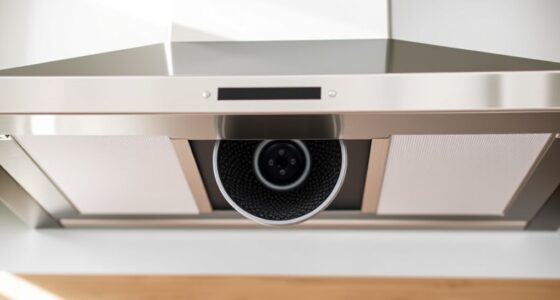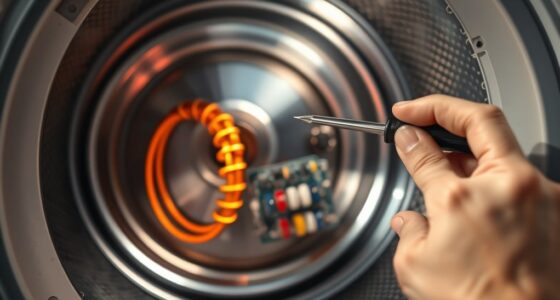Ceramic heaters warm up in a few minutes by using ceramic plates and fans to quickly heat the air, making them great for small spaces, while infrared heaters emit instant radiation for spot heating. Oil-filled radiators take longer to heat but offer steady, long-lasting warmth, ideal for larger rooms. Each type has different energy efficiencies and safety features. To discover which suits your needs best, explore more about their advantages and proper usage.
Key Takeaways
- Infrared heaters heat objects directly and provide instant warmth, ideal for spot heating, with nearly 100% energy efficiency.
- Ceramic heaters warm air quickly using ceramic plates and fans, taking several minutes to reach optimal temperature.
- Oil-filled radiators offer long-lasting warmth through convection but have the slowest warm-up time of 10-30 minutes.
- Infrared heaters are highly energy-efficient; oil-filled radiators consume more energy but retain heat longer.
- Safety features like automatic shutoff and proper placement are essential regardless of heater type.
How They Work: Heating Mechanisms and Heat Delivery

Space heaters utilize different technologies to generate and deliver heat efficiently. Ceramic heaters use ceramic plates attached to metal coils that heat up when electric current passes through. The ceramic absorbs heat and radiates or convects it into the air quickly, providing fast, localized warmth. Their lightweight, compact design makes them easy to move and perfect for small spaces. Oil-filled radiators contain sealed oil heated by electric coils; the oil stores heat and slowly releases it through convection, offering steady, long-lasting warmth. Infrared heaters emit infrared radiation that directly heats objects and people, not the air. They deliver instant warmth, working like sunlight, and are ideal for spot heating. Each type’s mechanism ensures efficient heat delivery suited to specific needs and environments. Additionally, the integration of automation technologies in heating systems can optimize energy use and improve user control. Modern advancements in energy efficiency are making these heaters more sustainable and cost-effective for consumers.
Speed and Efficiency: Warm-up Time and Operating Costs

Infrared heaters heat up almost instantly because they emit infrared radiation that warms objects and people directly, often within about a minute. This quick response makes them ideal for immediate spot heating. Ceramic heaters take longer to warm up, as they heat the air through a ceramic element and often use a fan, typically needing several minutes. Oil-filled heaters are the slowest—they heat the oil inside first, which can take 10 to 30 minutes. Some models with PTC elements or fans reduce warm-up time but still lag behind infrared and ceramic options. Infrared heaters are energy-efficient, converting nearly 100% of electricity into direct heat, while ceramic models operate at 85-90% efficiency due to fan and air heating. Oil-filled heaters consume more energy over time but retain warmth longer, affecting operating costs. Additionally, creating a cozy farmhouse bedroom ambiance can involve using efficient heating options to maintain comfort and warmth during colder months. Incorporating efficient heating technologies can further optimize energy use and enhance comfort throughout the house.
Best Uses and Safety Considerations

To guarantee safe and effective heating, you need to pay attention to certification and safety features. Ensure your space heater has safety certifications from UL, ETL, or CSA, confirming it meets safety standards. Look for automatic shutoff sensors to prevent overheating and tip-over switches to cut power if it falls. For damp areas, choose models with appliance leakage current interrupter (ALCI) or ground-fault circuit interrupter (GFCI) plugs to avoid shocks. Keep heaters at least 3 feet away from flammable materials like curtains or furniture, and always place them on stable, nonflammable surfaces. Never use extension cords, and unplug heaters when not in use. Regularly inspect for damage, and avoid leaving them unattended to reduce fire and injury risks. Home security systems can offer additional safety by alerting you to potential hazards or unauthorized access around your home.
Frequently Asked Questions
Which Heater Type Is Safest for Homes With Children or Pets?
You’ll find that oil-filled heaters are the safest for homes with children or pets because they have no exposed heating elements and warm up slowly, reducing burn risks. They’re heavy and stable, less likely to tip over, and include safety features like tip-over switches and overheat protection. Just be sure to place them away from curious kids and pets, and always supervise to maintain a safe environment.
How Do Noise Levels Compare Across Ceramic, Oil-Filled, and Infrared Heaters?
You’ll find that oil-filled and infrared heaters operate quietly, producing almost no noise, making them ideal for bedrooms or quiet spaces. Ceramic heaters tend to be louder because of their fans, with noise levels around 45 dBA, which might be distracting. If keeping your environment peaceful matters most, choose oil-filled or infrared models. Ceramic heaters are better if you need quick heat and can tolerate some noise.
Can Infrared Heaters Effectively Warm Large Open Spaces?
Yes, infrared heaters can effectively warm large open spaces. You’ll notice instant comfort because they directly heat objects and people rather than the air, which often disperses quickly outdoors or in drafty areas. Their focused radiant heat reduces energy waste, making them ideal for expansive environments like warehouses, patios, or industrial settings. Plus, their ability to maintain warmth without relying on air circulation helps keep large spaces comfortably heated efficiently.
Are There Any Health Risks Associated With Fan-Based Ceramic Heaters?
You should be aware that fan-based ceramic heaters pose some health risks. They can circulate dust and allergens, which might worsen allergies or asthma. The dry heat can irritate your respiratory system and dry out your skin. If the heater overheats or malfunctions, it increases fire and burn hazards. To stay safe, keep the heater away from flammable objects, make sure proper ventilation, and avoid leaving it unattended for long periods.
How Long Do Oil-Filled Heaters Typically Last Before Needing Replacement?
You can expect your oil-filled heater to last between 10 to 15 years with proper care. Regular maintenance, like cleaning vents and inspecting components, helps extend its lifespan. Avoid high power use and voltage fluctuations, and store it properly during off-seasons. Keep an eye on safety features, and replace it if you notice safety issues or significant inefficiency, ensuring safe, long-lasting operation.
Conclusion
Choosing the right space heater is like finding the perfect tool for your cozy corner. Whether you prefer the quick warmth of infrared, the steady comfort of oil-filled, or the focused heat of ceramic, each has its place. Consider your needs, safety, and efficiency to make the best pick. Remember, the right heater will be your warmest ally—turning your space into a haven where comfort blooms like a spring flower.










